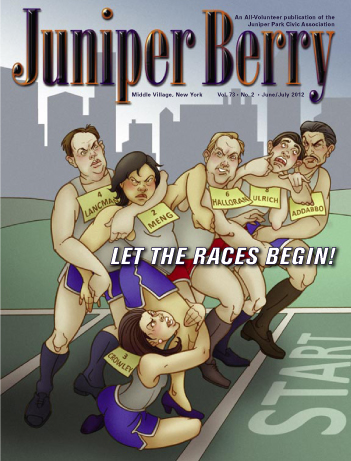In September 1960 I left JHS 73 behind and entered the imposing structure that was Grover Cleveland High School. It looked more like a college. Teachers helped process us, the incoming 10th graders, by recording our height and weight among other things. They also took our picture, not individually, but in group photos. Someone then cut out our faces to create individual mug shots. I was carded as 6’3” and 188 pounds, and looked thin for the first time in my life.
There was another surprise for kids like me coming to high school from a Junior High School. We soon discovered that academic programs for 10th graders between JHS and HS were not well coordinated.
Grover Cleveland had an Olympic sized pool and both boys and girls had to take swimming. While the girls donned stodgy woolen suits, the boys swam in the nude. At least once during any semester the girls were let in from their side of the pool too early. The squeals could be heard throughout the building and down Himrod Street!
Just before you went through the door to the gym, there was a trophy case with football uniforms including leather helmets dating from the early 1930s when the school opened. The rumor was that a student died playing football and the sport was dropped.
The really big sport at Cleveland was soccer. Always among the top schools in the city, Cleveland’s roster looked like Coach Singer had recruited players off the streets of Frankfurt, Stuttgart and Berlin. The German connection to the neighborhood was strong, and was reflected in the team’s superior performance. Probably not anywhere near unique, but shocking by today’s standards, the school had a rifle team (photo upper right) complete with a shooting range in the basement.
Of great personal importance to me, was basketball coach Ed Michaels. Michaels taught the fundamentals, and I who knew nothing soaked it up. More important still, it was a boost to my self-esteem. I went from nobody to somebody in a flash. Being one of the 15 boys on the team (Cleveland only had a varsity), was something in a school with over 3,000 students.
I remember the cafeteria was a depressing place. If you didn’t get assigned to a table with someone you knew, you were sure to have problems. I once made the mistake of retaliating and received a bowl of spaghetti in my face.
The City provided school bus service if you lived more than a mile away. My mother once organized a successful campaign to bring bus service to our block. I joined some of the neighborhood kids in taking up a bet (i.e. dare) that we could walk all the way to Grover Cleveland and back for a whole school year. This actually happened, although some kid’s mom drove us to school when the weather was really bad. The most dangerous part of the route was when we walked the narrow two lane road (Eliot Avenue) that served as the boundary between two cemeteries.
When my sister Margaret arrived at Grover Cleveland in l970, she faced the brunt of school desegregation. Beforehand, African American students were an extreme minority, maybe 5% of the population. The black kids were small in number and mostly kept to themselves. In 1963 the fading white street gang culture was giving way to black militancy. There was fear and some violence.
Nevertheless, in 1963 the Cleveland GO President was Paula Jay Miller a black student.
Academically, the Cleveland girls excelled at something called the commercial course. It prepared them for careers in blue collar office jobs. Most students took the general studies course, and the minority the college prep academic course. There was a sign by the principal’s office in the spring showing how many students had been accepted to full-time colleges. The figures were remarkably low, even for 1963.
Two weeks after graduation at the Ridgewood Theater, we packed the family car and headed for college upstate. But, Cleveland was in my rear view mirror with a striking vision of where I came from, but not a clue as to where I was going.




